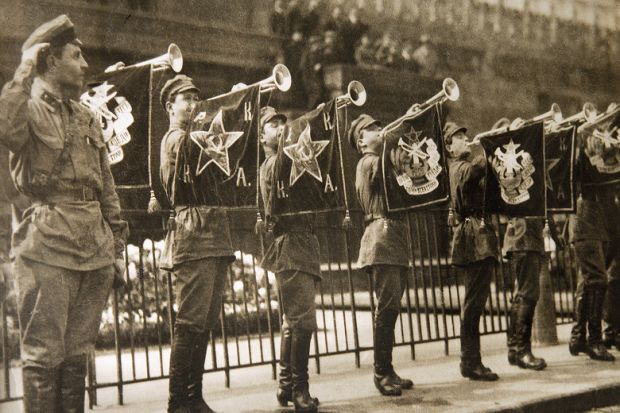There can be few areas of cultural history as prone to the afflictions of cliché as the study of musical life under conditions of totalitarianism. That which is recognised as reflecting the workings of a complex culture industry when located in a pluralist society is almost always reduced to a story of propaganda, “distortion” and the flashing of ideological messages authored by the relevant source of all evil at the top; the alternative is one in which the field of musical activity is constructed as a space of refuge from that evil, as an oasis of supposedly unpolitical civility in a desert of ideological barbarism. Either way, the delusions and conceits of the musical world are never far from the surface.
For this reason alone, Pauline Fairclough’s fine study of orchestral musical politics in Moscow and Leningrad during the Leninist and Stalinist eras is to be warmly welcomed. For sure, she is attuned to the various ways in which sometimes abrupt shifts in Soviet politics produced moments of greater or lesser official acceptance of different corners of the repertoire – old and new, foreign and indigenous, Modernist and traditionalist. These shifts in what was sanctioned politically were regular enough that few individual pieces of music became genuinely canonical; musicians or composers who got caught unawares by these shifts sometimes faced the worst.
However, Fairclough also underlines the comparative openness of the various discourses surrounding art music in the Soviet Union. Neither music nor writing about music was simply a medium of ideological instruction, a tool with which the settled view of the regime was communicated to the masses. Rather, they were both sites on which ongoing arguments about what constituted good Soviet culture were played out. Competing visions of who Tchaikovsky, Mussorgsky or Beethoven were fed into ongoing explorations of who the new Soviet citizen-listener was meant to be. The resistance of most art music to colonisation by the more crudely official versions of state ideology was such that the argument was never really resolved. Although there were moments when parts of the repertoire were forcefully jettisoned – Wagner was swiftly taken off the menu in the summer of 1941 – the performing repertoire reflected at most the indirect influence of the regime’s politics at any given point.
The merits of this approach are many. In place of an emphasis on cynicism, manipulation and the “abuse” of cultural icons, Fairclough rightly foregrounds the authenticity of various commentators’ ideological, cultural and intellectual commitments; in place of a top-down account that elides the voices of conductors, performers, programme-note authors and other actors she is able to show how these, along with cultural administrators and party functionaries worked to produce the discourses she seeks to analyse.
Further work will help us to understand better how Soviet cultural institutions were received by the audiences (both old and new) they sought to shape; it would also be interesting to see whether the stories that Fairclough has uncovered in respect of prestige institutions in major cities were reproduced in the provinces. This carefully researched, superbly well-written and thoroughly persuasive account will, it is hoped, stimulate other scholars to follow in Fairclough’s steps.
Neil Gregor is professor of modern history, University of Southampton. He is writing a book on symphonic music in Nazi Germany.
Classics for the Masses: Shaping Soviet Musical Identity under Lenin and Stalin
By Pauline Fairclough
Yale University Press, 296pp, £35.00
ISBN 9780300217193
Published 16 April 2016




